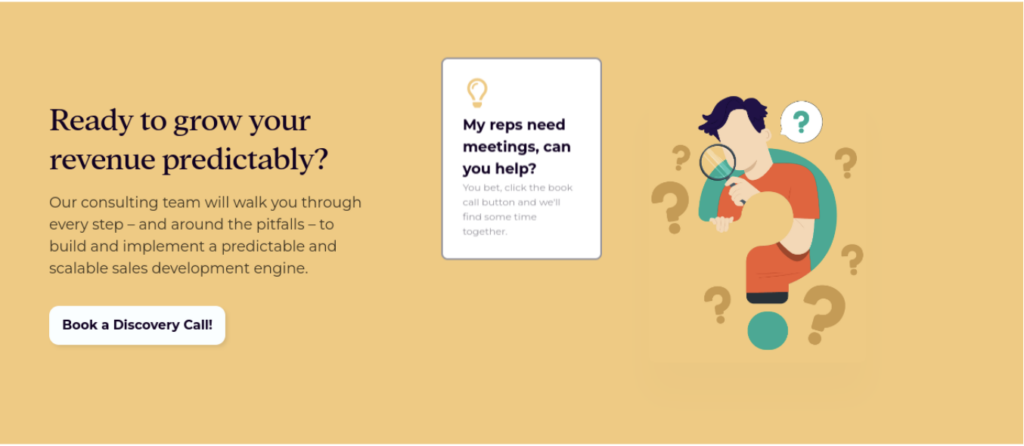How to Convert Traffic into Leads: 10 Strategies
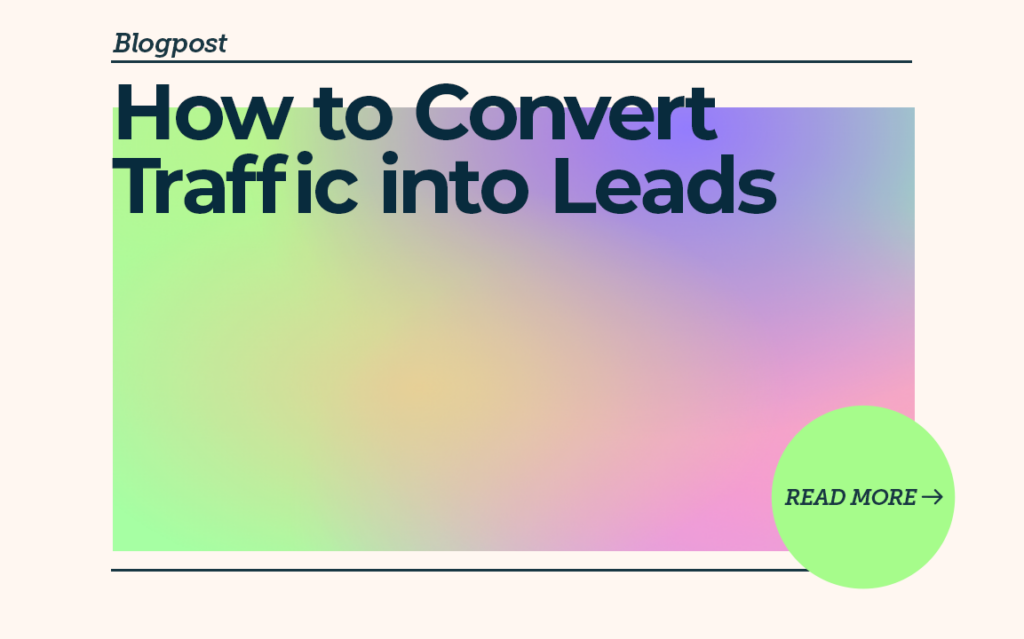
Good marketers can bring loads of traffic to their business. Great marketers convert traffic into leads.
This is no easy task. In most cases, optimizing the pipeline of traffic converting into leads takes a rigorous examination and experimentation with each step to increase sales with your existing traffic.
Thankfully, most marketers don’t need to reinvent the wheel. We can follow established practices and learn from others’ mistakes.
In this article, we’ll explore what prevents you from converting leads from website traffic and share ten strategies you can use to improve.
Pitfalls Preventing Traffic from Converting into Leads
The most prominent reason marketers fail to convert traffic into leads is that they are attracting the wrong type of traffic. People not interested in your services and products will not convert at all.
An example of this is an IT company that works with SaaS product owners but writes content for other IT specialists. This type of content will not attract decision-makers, so the company will not see a high conversion rate on that traffic.
Another example is failing to add stop words in your Google search ad campaign. Your ad will then be shown for the wrong keywords, and even if people click on the link, they won’t convert.
The second biggest reason is poor communication through your web pages. When a person interested in a purchase doesn’t see the information they need and can’t find it, they won’t even bother looking and go straight to the competition.
Poor communication can manifest in multiple ways.
Your landing page can fail to deliver crucial information about your services or products. For instance, if you do not list essential product features for the user or describe your services so vaguely, it’s hard to understand what you are doing.
Your website can be challenging, with links to category pages hidden on a single page instead of in the navigation menu.
Your pricing and shipping information can be nonexistent or hard to find.
Many marketers make the mistake of not creating a clear call to action. This leaves an interested visitor thinking, “Okay, now what?“
Finding out how these issues impact website conversions and how to fix them requires a methodical approach.
Clever Hacks to Turn Traffic Into Leads
Here are the ten tips on converting leads from website traffic that will work for any business.
Understand User Intent and Get the Right Traffic
Since the quality of the traffic is crucial to converting it, this should be your primary focus. Your main tasks here are:
- Reevaluating your ideal customer profile
- Ensuring that your understanding of your ideal customer profile (ICP) is still relevant
- Analyzing your traffic generation efforts to see whether you’re attracting them
The first two tasks involve collaboration between multiple departments. If you can’t do it now, you can quickly check the ICP in your company’s software and confirm that it aligns with the data from the sales department.
Checking whether you’re targeting the right demographic in paid ad campaigns is easy. Most tools have good targeting options that narrow down to specific demographics.
Understanding whether you appeal to the right audience with organic traffic is a bit more complicated. You can do this with SERP analysis, which helps you understand search intent.
Knowing the keyword’s search intent and serving content that answers it will satisfy the users and increase the odds of a conversion. Here’s how you do it for any keyword.
Enter that keyword into Google and analyze the results.
- Is the content in SERP informational or commercial?
- What points does this content bring up?
- How does this content cover the topics?
- How do they structure CTAs?
Let’s explore this with the keyword “how to find the right leads.”
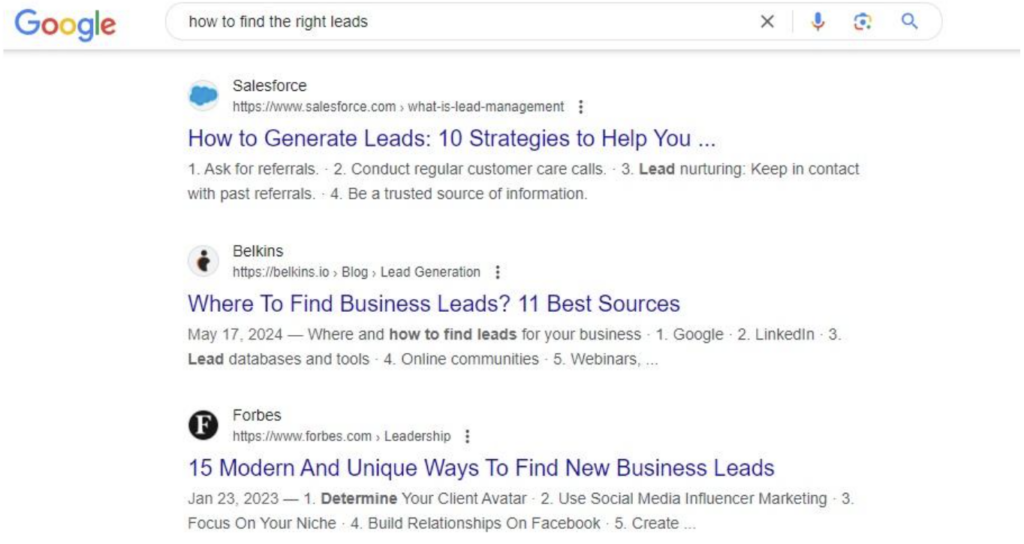
A brief analysis shows that the top three results are informational articles and two from corporate blogs. Their content provides a free guide and promotes their tools or services, leaving easy-to-follow CTAs.
From this, we can conclude that this is an informational keyword. The target audience of this keyword is lead gen specialists, SDRs, and CEOs. If that’s what you’re after, this is a good keyword for optimizing a page.
Use a specialized tool, such as the SERP analyzer by SE Ranking.
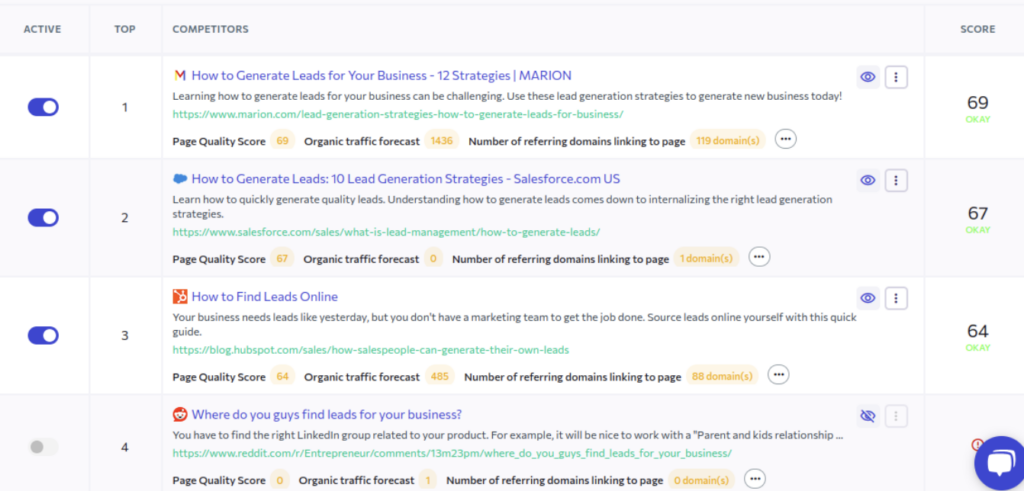
It will show SERP for your keyword and provide helpful SEO insights on the websites’ quality of on-page and technical optimization, page experience, content, number of referring domains, and traffic forecast.
Use this information and read the pages to learn how they structure the content and what points they raise. The odds are that users who Google this keyword want to know about those points, and explaining them well while tying your product to them might help convert website visitors to leads.
For product pages, analyze what key product characteristics are brought up on the page and list them for your product.
Create and Optimize Content with Users in Mind
With the information you received from analyzing user intent in the previous step, you can create better content. Craft user-oriented content that answers the search intent at each step of the sales funnel and will help convert website visitors to leads.
For informational pages, serve content that fully answers the search intent and explains the topic in as much detail as needed. Then, you can either showcase how your company can help solve that problem or capture users with a newsletter subscription form.
For product and service pages, add all the necessary details about what you’re selling, as well as information that helps users make a decision, such as reviews, testimonials, or comparisons. This makes the path from consideration to purchase easier and helps convert traffic into leads.
If there’s a SERP feature, like a shopping list or a featured snippet, try optimizing for it to get more targeted traffic that converts.
Make Your Website Simple to Browse
If users can’t find something on the page or the website, they’ll likely leave, robbing you of website conversions. So, make browsing your website as easy as possible.
Start by ensuring your website design is simple and doesn’t have unnecessary elements. If your site’s visual style is cluttered with too many things a user can look at, it can become more challenging to navigate.
Keep it minimalist. This way, there are fewer elements you can direct the user’s attention to, and it’s easier to convert them.
Then, look at the navigation menu design. Ensure all elements that typically lead to conversion are easily accessible from any page. Important landing pages, category pages, and comparison pages should be in the footer or header of the page in places where users are accustomed to look for them.
Then, analyze the pages with low conversion rates. Look for opportunities to communicate key information better, especially the call to action.
Create Effective CTA
You might be losing sales when you drive targeted traffic to your pages and clearly communicate what the users want to read but don’t show them a clear path to conversion. That’s why you need to incorporate effective CTAs in your pages.
A service or landing page needs several CTAs across the page and a large one at the bottom.
Informational pages can incorporate soft CTAs, asking the reader to follow the blog, podcast, or other source of information your company can use to convert website visitors to leads later. You can also add a CTA with a link to your sales page when it makes sense in the article.

A classic way to introduce a more prominent CTA that leads to a sale is at the bottom of the article page.
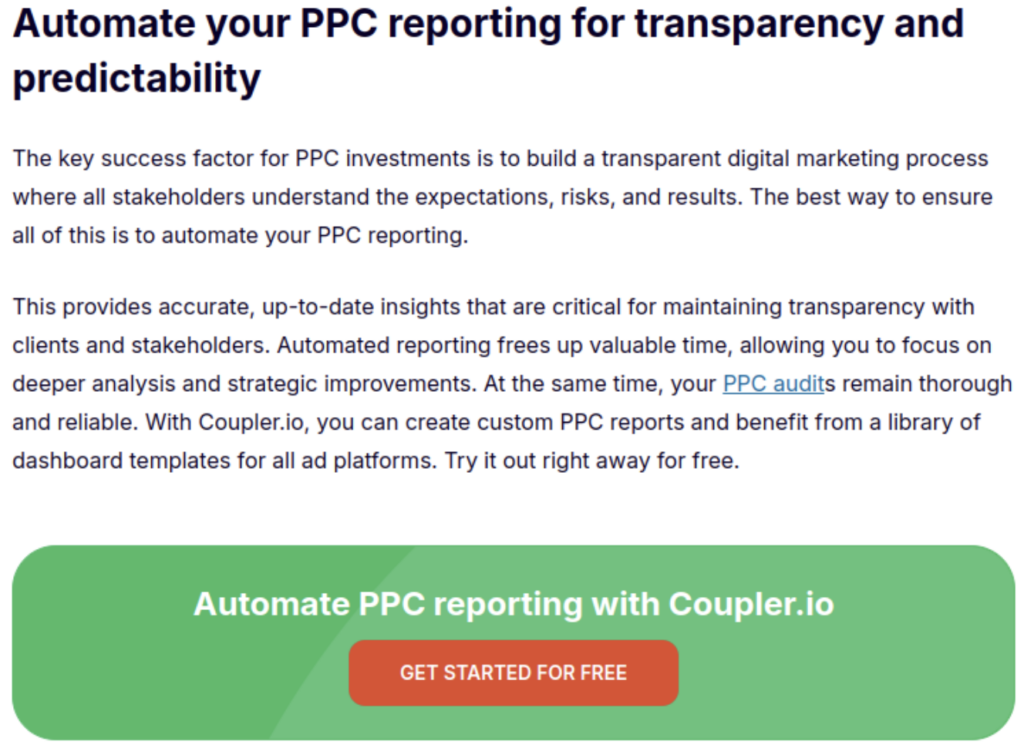
Show You’re Better than Your Competitors
People who come to your website do not exist in an informational vacuum. They know your competitors’ exist and will likely compare your company to them.
To improve the odds of converting website visitors to leads, show them how you differ from the competition. Include your unique selling proposition and communicate what makes your company better.
You can also directly compare your services with the competition and include them in the navigation menu.

Create Offers for Every Stage of the Buying Journey
Chet Holmes suggests in his bestselling book that only 3% of the market are ready to purchase at any given moment. While there’s no way to know that for certain, it’s safe to assume that Holmes is at least somewhat right: most people interested in your services won’t purchase the spot.
That’s a reason to be in touch with them and be there when they’re ready. Here are a couple of ideas on how to do that:
- Offer to subscribe to your social media.
- Offer to subscribe to your newsletter.
- Offer to download an ebook.
- Offer to take part in a webinar.
- Offer a free or cheap consultation call.
When you make it easy to engage with your conversion funnel, traffic that doesn’t convert right now will convert in the future.
Create Lead Magnet
A classic, time-tested method of getting the contact information of decision-makers is putting highly valuable content behind an email wall. If you want this to help convert traffic into leads, you have to make sure the content provides value to the lead. Here are a couple of ideas:
- eBooks with detailed guides on a single topic
- eBooks with proprietary research
- Useful templates
- Useful free tools
When you create a lead magnet, promote it on your site. If visitors don’t know about it, they won’t convert.
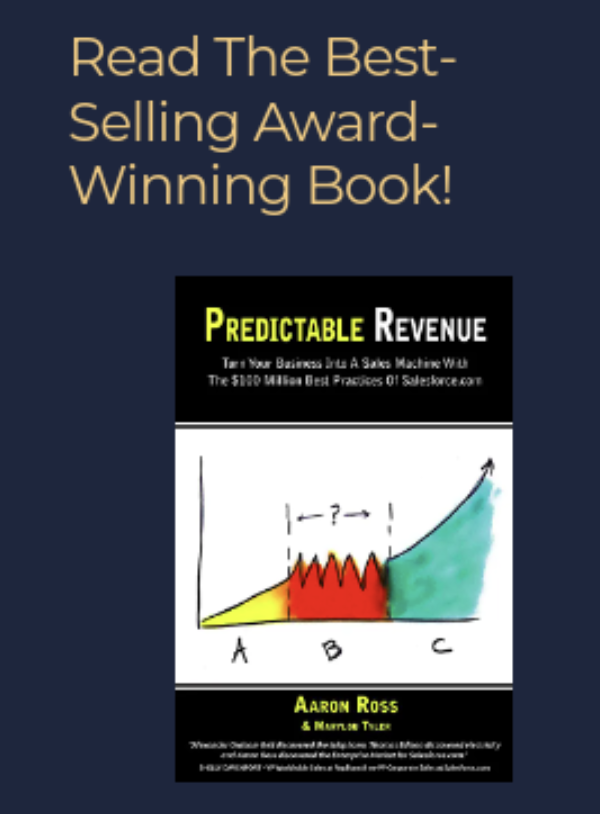
Radiate Trust
To improve the odds of converting website visitors to leads, show them they can trust you. Start by making your website look professional. This is the bare minimum:
- Use an SSL for a safe connection.
- Provide clear business and shipping information.
- Show company policies.
- Use unique images, not AI-generated or stock photos.
You should also consider including trust signals on the key pages. 72% of consumers trust testimonials, so including them on landing pages will improve conversion.
Retarget Visitors Who Didn’t Convert
Converting traffic into leads doesn’t have to stop when people leave your site. Set up retargeting campaigns across your marketing channels, like Facebook or Google, to show ads of your business to past visitors.
Don’t show those ads to anyone who visits your site, though. Focus on the ones who did a converting action, like visiting a pricing page. This helps narrow down the ads to people who might be interested in what you offer and keep the costs down.
A/B Test Your Ideas
A poor understanding of what prevents converting website visitors to leads is one of the top reasons marketers believe their conversion optimization efforts fail. Take steps to learn more about conversion rate optimization.
One of those steps is A/B testing your ideas about improving your site. For instance, if you want to change a CTA on the main page, serve half the users the new CTA and the other half the old one. Record the results and analyze the difference between the two.
Do A/B testing when possible, and you’ll learn the guiding principles for actions that improve conversion rate.
More Website Traffic, More Leads
A good idea is to invest in conversion rate optimization before spending significant money on scaling traffic. Once you reach a 2-5% conversion rate on the website, further progress will be difficult.
With those numbers, your best bet to get more leads is to get more targeted traffic that converts.
Invest in a combination of paid and organic traffic that works for you. Increasing organic traffic, whether on Google or social media, takes time and effort. Increasing traffic through paid ads requires a lot of upfront spending.
Research how your leads find out about your business and where they look for information about your industry. This can lead you to add more marketing channels to your list. It’s not uncommon to see B2B leads looking up information on LinkedIn or YouTube, and B2C leads can discover your business on TikTok or Instagram.
Do your research, devise a combination of organic and paid channels that works for you, and work to attract more visitors to your conversion-optimized website.
Summary
Driving more traffic to your business is always a good idea, but converting traffic into leads more efficiently is even better. The three key areas to focus on are:
- Driving targeted traffic to your pages
- Communicating your value clearly
- Analyzing the results
Implementing these three elements guarantees you to see your conversion rate go up.
